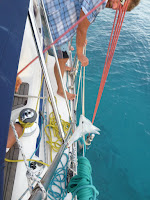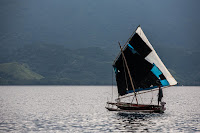Dave had been doing some research at home in Australia and he’d passed on information that there might be boat builder near Samarai Island in the China Strait. If so, they might be able to provide us with a permanent seaworthy replacement.
As Samarai was only a minor detour from the direct route to Alotau (where there was an airstrip, small seaport and enough commercial activity to make us believe there could be help there) we decided to make for there in the first instance.
The new rudder performed fairly well; being unbalanced it was a bit heavy on the helm and its smaller area limited how much sail we could safely run with. The autopilot would fight a losing struggle to hold a course with it so we switched to manual for the rest of the journey. Other than that, it was good to be moving again and we soon had the lines out looking to replenish our fish stocks, depleted during our short desert island ‘holiday’.
We could still just about see the anchorage at Duchateau Island when we had our first strike. Reeling in was proceeding easily when there were a few noticeable extra tugs on the line and a decidedly mauled mackerel tuna was brought aboard.
As we considered its condition, three grey-black shapes cruised to the surface in the dark water just off our transom – the sharks that had attacked our catch wondering where their potential snack had gone.
It was windless, grey and wet as we motored slowly up the channel towards Samarai Island in the early light of dawn, May 15. It was a discouraging sight – much smaller than I’d imagined and whilst the roofs of many buildings and substantial sheds attested to the islands long occupation and various roles as provincial headquarters of the pre WWII Australian administration of PNG and wartime seaplane base, they were now just relics. As we got closer we could see the sheds were dilapidated and the wharf was largely in ruins. A few local souls hung quietly around the remains of the dock apparently waiting for speedies to run them to Alotau or elsewhere.
We put ashore in the dinghy to see what we could find out. As we were technically re-entering PNG, the Customs officer was roused though he advised that we should warn in at Alotau. After we queried whether Samarai was still a Port of Entry he then seemed to think he ought to do some work that day and marched me off to his office to spend 45 minutes filling forms.
The people were friendly and helpful but the news was not good: there were no boat builders and the slip across the Strait had closed. However, it was suggested that our best bet might be to head to the end of Milne Bay past Alotau town to NAWAE Construction, an industrial yard on the coast that had a big ship slipway. Whilst we had seen nothing so described during our previous stop in Alotau and they weren’t answering the phone number we’d found in the Customs officers ancient Yellow Pages, Jeremy had a recollection that he’d seen something whilst exploring the area when waiting there for us to pick him up. The chart showed it was the end of the line, in many ways, but it was worth a look. It also meant we’d pass through the China Strait, a locally historic stretch of water named in the late 1800’s by Captain John Moresby as a shipping short cut around the eastern PNG mainland to points in the northern Pacific.
Passing Alotau and motoring towards NAWAE’s reported location the coastline gave nothing away so there was a sense aboard that we might be heading to another dead end.
However, as we rounded a small headland before Stringer Bay we were presented with a picture of a serious operation; a heavy slipway with a ship in position and obviously undergoing some major work, an organized yard, and men in hard hats. There was even a small residential section with large houses on the waterfront and a jetty.
 |
| Franks Pier - our refuge in East PNG |
The helpful engineering staff at NAWAE agreed to have a look at the possibility and we dropped the blade again for inspection. However, it soon became apparent that their facilities and the limited availability of suitable materials locally would only produce another temporary fix and that at significant cost. A brand new rudder was the best solution but this would clearly take many weeks to procure. Unfortunately, as the crew had originally expected to be disembarking in Cairns two days previously, real life was now calling and there was no one with the time to remain indefinitely to babysit a yacht at anchor in this insecure location.
 |
| Leg 6 |
But that's another story...
Steve.






































































